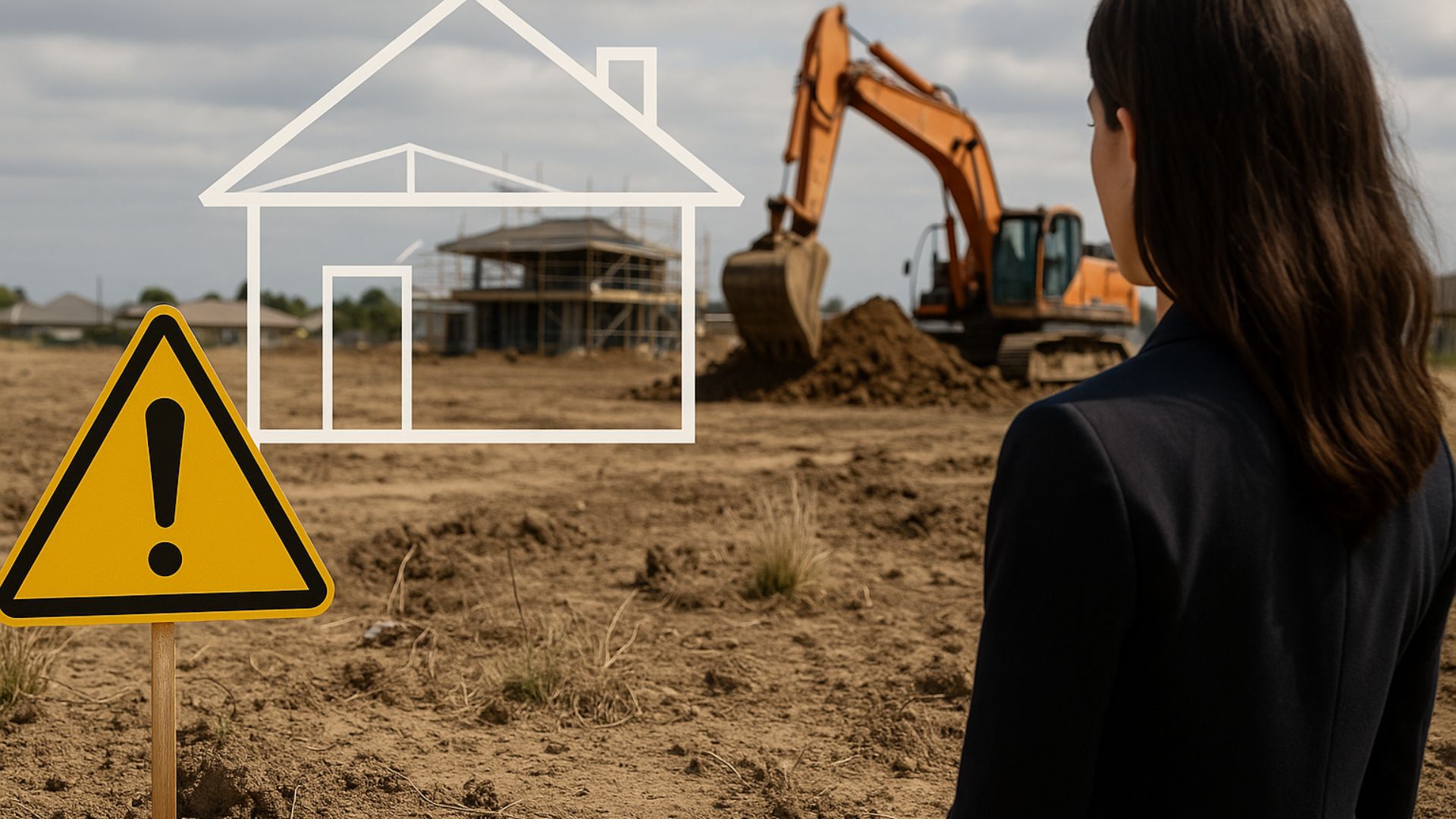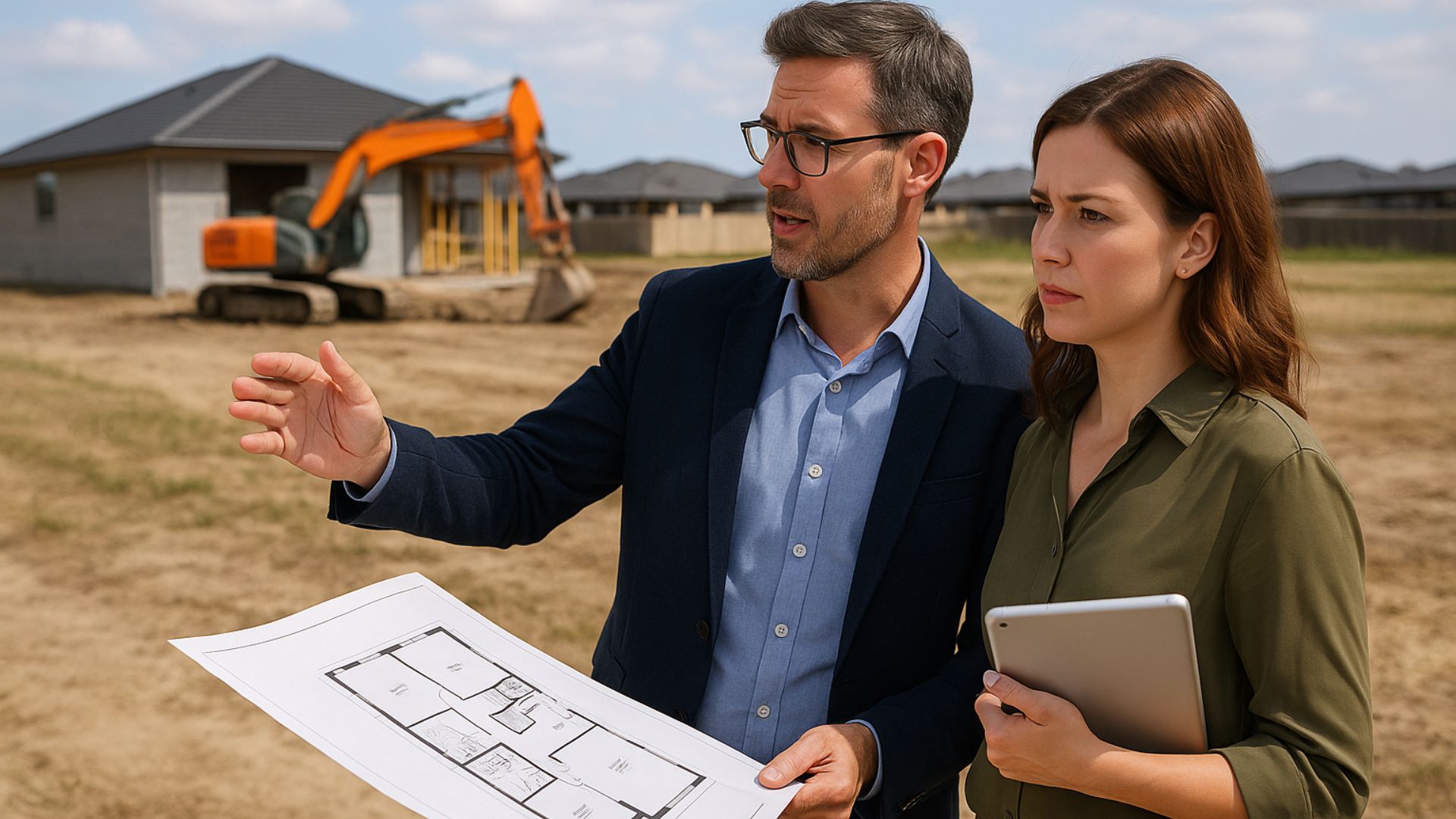Buying a block of land to build an investment property can seem like a smart move — the promise of designing your own property, maximising depreciation benefits, and creating equity from the ground up is appealing. But while the idea of constructing a property from scratch can sound exciting, the reality is, that it has a lot of complexities and costs involved where first-time investors may get trapped. Many investors underestimate the time, costs, and knowledge required to manage a successful build. Without a clear understanding of the process, what starts as a great opportunity can quickly spiral into a stressful, expensive, and drawn-out ordeal.
Before you embark on a build project, its important you’ve considered all the key risks before you buy the land and have a clear understanding of the build process.
Risk: Not Understanding the Process
One of the most common mistakes investors make is purchasing land before understanding what is actually involved in turning that empty block into a completed property. The process of building involves numerous stages — from soil testing, site preparation, design approvals, and council permits, managing trades, progress payments, and final inspections. Keep in mind that all the costs for the property, and mortgage repayments have to be made with no income being generated from the property- because there is no property available to be leased.
If you don’t know how to interpret site reports, understand zoning restrictions, or navigate council planning regulations, you can end up with unexpected complications that delay construction and inflate costs. For example, a block that looks flat may actually require significant earthworks due to poor soil classification, or it might sit in a flood zone that requires elevated foundations or special drainage.
Without a clear understanding of these issues upfront, you could face thousands of dollars in additional expenses — or worse, find out that your chosen design can’t even be built on the block you’ve purchased.
Understanding the Build Process
A successful build project requires understanding every step from pre-construction through to handover. This includes:
- Pre-purchase assessments: checking zoning, covenants, easements, and soil classifications.
- Design phase: selecting a floor plan suited to the land’s orientation and slope while staying within local planning requirements.
- Approvals and permits: obtaining building approval from the council or private certifier.
- Construction phases: progressing through slab, frame, lock-up, and fit-out stages while managing payments and quality inspections.
- Handover and maintenance: ensuring the property meets contract specifications and addressing defects.
Each stage involves timelines, approvals, and costs that must be carefully tracked. Understanding the sequence of these stages and how they interconnect is crucial for keeping your build on schedule and within budget. Investors who enter the process without this knowledge can quickly lose control — not only financially, but also in terms of decision-making and oversight.
Risk: Costs Blow Out of Control
Cost blowouts are one of the biggest risks when building a property. They often occur because of poor planning, underestimated site costs, or inadequate contingencies. What many first-time investors don’t realise is that “base build prices” quoted by builders usually cover only the bare minimum — often not including essential elements like driveways, landscaping, fencing, or higher-quality fixtures.
Additional costs can arise from unexpected soil conditions, rock excavation, service connections (such as water, sewer, and power), or changes to the original design. Even small variations, such as upgrading fittings or altering the layout mid-build, can cause budgets to spiral.
Inflation in the construction industry — particularly since the COVID-19 pandemic — has added further pressure. Labour shortages, material delays, and supply chain disruptions have driven up costs and extended build times across Australia. Without an accurate understanding of current market conditions and the true cost of construction, investors can find themselves with a project that no longer stacks up financially.
In the worst cases, cost blowouts can erode the profitability of the investment entirely, leaving the owner with a property that costs more to build than it’s worth, ruining their investment portfolio dreams.
Hidden Danger: Holding Costs
When considering to build, it’s easy to focus on the project and construction costs and forget about the holding costs that start to accumulate along the way. These include interest payments on the land loan, council rates, and sometimes even land tax — all before the property generates any rental income.
Any delays in the build process can significantly increase these holding costs. For instance, if council approvals take months longer than expected or the builder pushes back the start date by a month or two, you’ll continue paying interest without any offsetting income. In addition, you’ll need to cover insurance for the land and potentially contribute to utilities or maintenance if the site requires upkeep during extended construction periods.
Understanding and budgeting for these holding costs is vital to ensuring your investment remains financially viable. A realistic timeline and cash flow plan can prevent a promising project from becoming a financial drain.
Risk: Choosing the Wrong Builder
Selecting the wrong builder can lead to disastrous outcomes. Unfortunately, Australia has seen an increasing number of builder insolvencies in recent years, leaving investors stranded mid-construction with half-finished homes and no clear recourse.
Beyond the risk of insolvency, an inexperienced or unreliable builder can cause major headaches — from poor workmanship and communication issues to delays, disputes over variations, or breaches of contract. Some builders offer attractively low initial quotes that later inflate through hidden fees or change orders. Others may lack the capacity to complete projects on time due to overcommitting their workload. It Is crucial to ensure the builder has a current licence, and is adequately insured in case anything does go wrong with your project.
A good builder will provide transparent pricing, clear contracts, and regular communication throughout the project. But without knowing what to look for in a builder’s track record, financial stability, and inclusions, investors can easily be caught out. The wrong builder can turn an investment dream into an expensive, drawn-out nightmare. An experienced Buyer’s Agent who has completed builds in the area can assist you to choose the right builder, and they will often have contacts on hand to offer some transparent pricing and reliable contracts. They will also have a touch in the industry on who to avoid and why, which can save you hundreds of thousands of dollars in your project.
A Buyers Agent Can Help Run the Process Smoothly
An experienced buyers’ agent who specialises in new builds can be the difference between a stressful, risky experience and a smooth, profitable project. A qualified agent understands the entire process — from identifying the right land in high-demand growth areas to vetting builders, negotiating contracts, and overseeing the build.
They can conduct due diligence before purchase, ensuring the land is suitable for your intended build and free from costly surprises. They’ll liaise with developers, builders, and council authorities to keep the project on track, and they can help you avoid overpriced or unsuitable blocks that would restrict design options or increase site costs.
Buyers’ agents also have access to trusted builders with proven track records, helping investors secure fixed-price contracts and avoid the risk of hidden extras. Their expertise can help identify where builders might cut corners or overcharge, ensuring the final product meets both quality standards and investment objectives.
For investors building remotely — particularly interstate — a buyers agent acts as your on-the-ground representative, monitoring progress and handling any issues before they escalate. Ultimately, this saves time, money, and stress while helping you achieve a stronger return on investment.
Should I Build an Investment Property?
Buying a block of land for an investment property can be an excellent wealth-building strategy — but only if you understand the complexities of the build process. Without this understanding, investors risk cost blowouts, delays, and poor financial outcomes.
From managing approvals to selecting the right builder and budgeting for holding costs, every stage of a construction project requires careful planning and professional oversight. An experienced Buyer’s Agent brings the expertise, industry connections, and project management skills needed to navigate this process successfully.
By engaging a professional who understands both property investment and construction, you can minimise risks, control costs, and ensure your build delivers the strong returns you set out to achieve. In a market where every dollar and day counts, that experience is not just valuable — it’s essential.
****
Thank you for reading our blog on Australia’s Post-Election Property Market. Make sure you head over to our YouTube channel by clicking here to discover more educational insights to level up your property investing including our latest video: Australian Property Market 2025 Forecast.
Disclaimer:
Aus Property Professionals Pty Ltd retains the copyright in relation to all the information contained on its website and in this guide. This guide, and any content provided in addition, or linked to resources, is general information only and not investment advice. As everyone’s individual situation is different, we advise individuals to always seek advice from relevant professionals such as legal, financial, accounting, and investing experts.
The intention of this guide is to be used for general information purposes only, in addition to your personal research and due diligence. We do not take any responsibility for any actions taken as a result of this guide as any actions should always be taken with consultation with relevant professionals who take individual circumstances to account.
Past performance doesn’t guarantee future results.
We have compiled the information contained in this guide from online resources, our research, and consultations, and we cannot guarantee the complete accuracy of this information, and we will always reference the resources where the data and information was derived.






